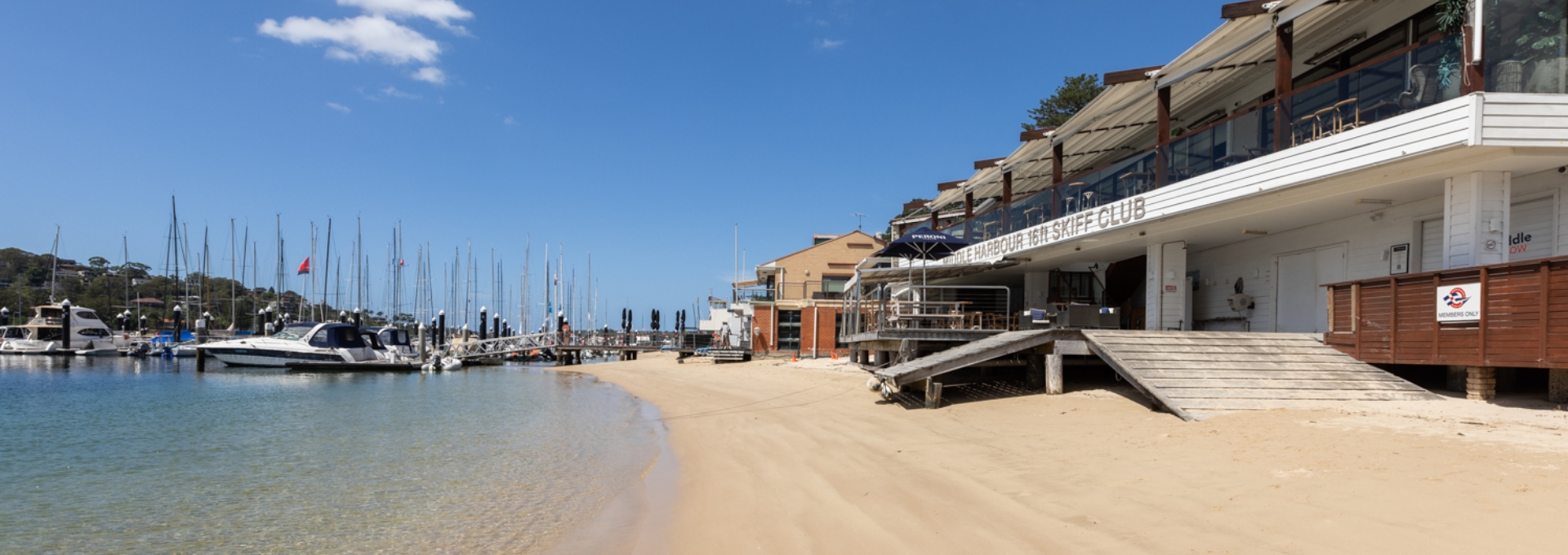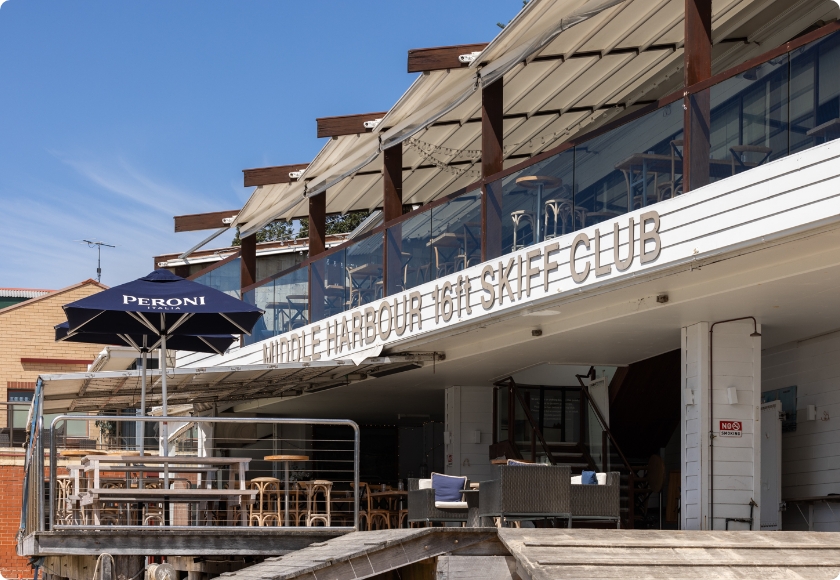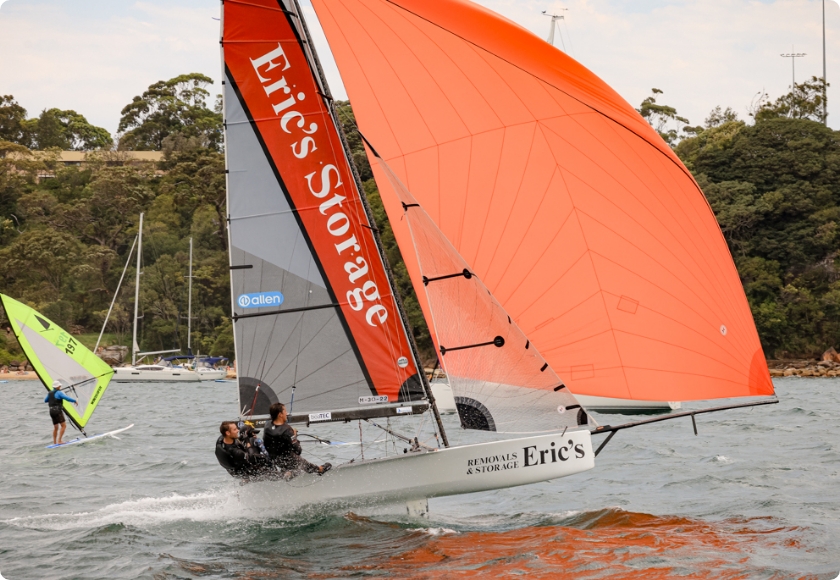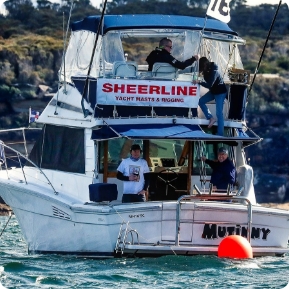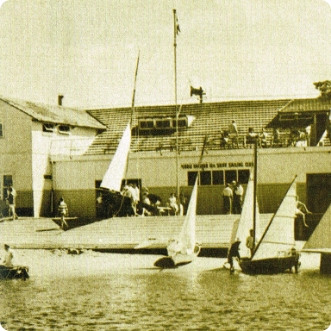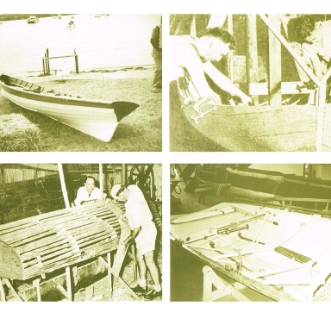The roots of the skiff date from the 19th century. Hardworking “skiffies” rowed cargos to and from the ships and passengers across the Harbour each day, then put up as much sail area as they could handle on their open boats, to race each other around Sydney Harbour, much to the entertainment of the public as to the profit of the local bookmakers.
The first 16 foot skiff was based on the “Watermans” skiff, chosen for its streamline shape, the dimensions of which have not changed much to this date although the lugsails and gaff rigs, with their solid timber spars and vertical cloths, are thankfully a thing of the past. The old boats were manned by four people, as much to carry the boat which weighed 114kg, versus 72kg of today’s skiffs, as man-handling the 20sqm sail area. A fifth crew was added after spinnakers allowed in the class.
Hearsay has it that the nucleus of the club was born in idle discussions beside Adams’s Boatshed, next to the Spit wharf. With sufficient boats between ten and twenty-two feet sailing in the area, to make up a club, a meeting was convened in September 1902 and “Middle Harbour Sailing Club” formed; the first race sailed on the 11th October 1902 and won by George Snow’s 16 foot skiff, “Fransie”.
The first Middle Harbour Regatta was held on 1st January 1903, more races and fund-raising aquatic carnivals followed, up until the First World War. In 1920 the club was re-kindled, the name changed, in 1927, to “Middle Harbour 16 foot Skiff Club”, reflecting the majority of the fleet sailing there. Competition was hot, Queensland had introduced a hull design which sailed flat and much faster downwind, New South Wales was not about to be left behind. It was not however, until 1936 that the first clubhouse was built, exclusively from funds raised by the members and voluntary labour.
In 1941 cheers resounded to the name of “J. Lyons” and “U-Dear” as the club won its first Australian Championship title. Despite being taken over by the Army in defense of the Spit, in 1942, the club grew and grew until, in 1946, the necessary permits were obtained to extend the club-house. A deck was built out six years later to make more space for rigging the skiffs, which were evolving by the minute, with the addition of buoyancy boxes to keep the lighter, faster craft, topped with Bermudan Masts and battened sails, afloat in a capsize.
In 1952 Jim “Salty” O’Rourke (nicknamed for fierce defense of his salt ration in Changi Prison) returned from the war to win the club’s second Australian Championship, in “Return”. Despite the reputation of many skiffies, the club did not hold a liquor license until 1955, the Middle Harbour skiffies who hung off the beams of their club in wild parties then swung off the trapezes of their skiffs, which were introduced to the class in 1958.
Membership continued to grow and the current club house was completed in 1961 again significantly supported by voluntary labour from club members. The sixties brought alloy masts to the skiffs, which gave greater flexibility and performance in a variety of wind strengths, as well as another Australian Champion – Ken Beashel, sailing “Seaforth”.
The 1970’s saw the hey-day of the Australian club and Middle Harbour 16 foot Skiff Club was no exception, reveling in a whirl of social and sailing activities. The hull shape of the skiff changed dramatically and materials development was at a peak. Trevor Beardsmore became two-time Australian Champion in his skiff “Minx”. In 1979 the skiff measurement went metric with only the name remaining imperial.
However the change of decade bought a change in fortunes. As the Government overturned club advantages within licensing and gaming laws, Middle Harbour Skiff Club struggled. Costs were cut concurrently with the reduction in skiff crew numbers down to three. With characteristic guts, flexibility and labour from the members, all nature of enterprise were run to keep the club afloat, before hitting on the idea to restructure and sub-lease the function area; a relationship lasting twenty years with the famous “Fresh Ketch Restaurant” was forged.
During the nineties the skiff became friendlier to sail. Boats were decked-in, the number of rigs was reduced, Highfield levers to bend the rig became a thing of the past as “ballooners” or asymmetric spinnakers and fixed poles, proven in speed and efficiency took their place.
Skiff sailing at Middle Harbour goes from strength to strength, four years ago the 13 foot skiff was introduced to bridge the gap from junior sailing, lost when the fourth hand “bailer boy” position on a skiff was cut. The club has had two Australian 13 foot skiff Champions; Dan Watterson (www.sheads.com.au) and Scott Cotton (Northside Sailing School) as well as another 16 foot champion, Lee Knapton (Bob Jane T-Marts Edgecliff). However, social evolution marches on curtailing “Boat races” with “Booze buses” and introducing a whole new alphabet from “X”-box to “E”. Once again the forecast changes but the skiffies tack again into the new breeze – a lift! A $4 M renovation and new catering agreement with Zest Waterfront Venues, is in place to take the club sailing through to 2034.
With the famous names of past champions; Beardsmore, Beashel and O’Rourke still ringing in the ears, a third generation of skiffing “Hendry’s” and a strong, growing junior fleet in the wings, another chapter in the exciting life of Middle Harbour Skiff Club opens and we hope that the brave -spirited, community-focused, egalitarian mate-ship of Middle Harbour’s 16 foot skiffies prevails long into the future.
(Thanks to “A Century of Skiffs and Schooners” especially Frank Bonnitcha and Don Audsley for the references.)



